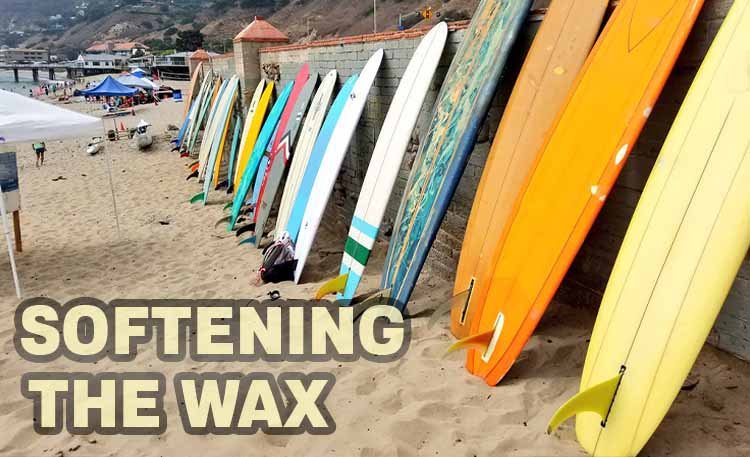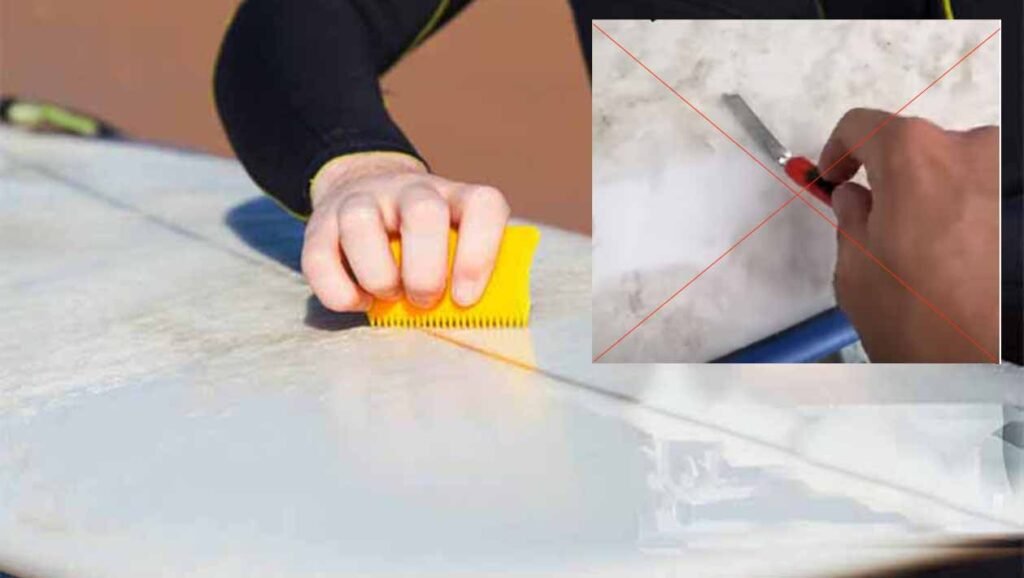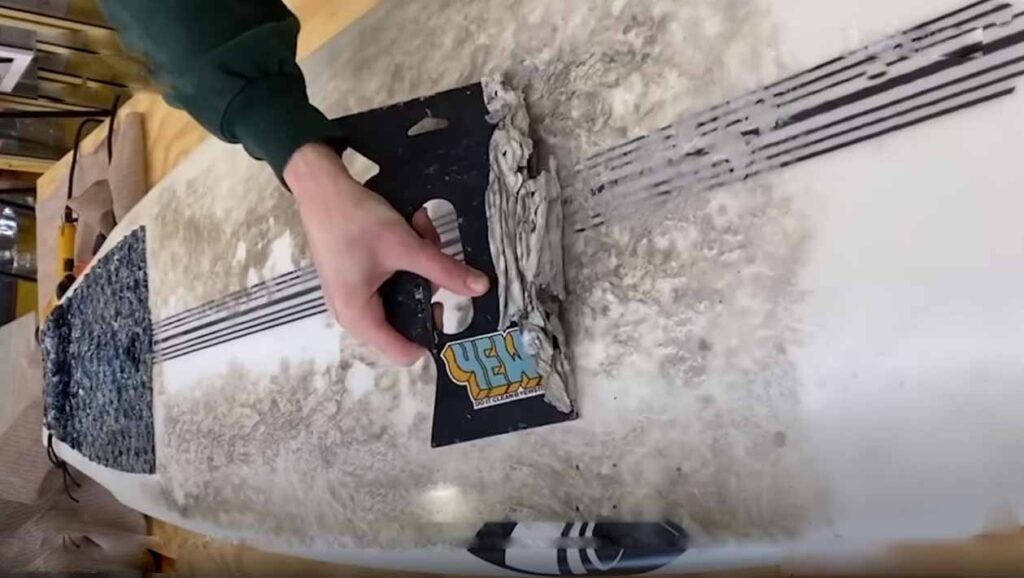As an Amazon Associate I earn from qualifying purchases.
This post contains affiliate links.
Maintaining your surfboard is crucial for optimal performance in the water. One fundamental aspect of board care is knowing how to remove old wax from a surfboard. This is a process essential for keeping your board in top condition. The accumulation of wax over time can affect your board’s performance. Making it necessary to periodically remove and reapply wax for a smooth and responsive ride.

In this guide, we’ll delve into the step-by-step process of effectively removing old wax from your surfboard. Let’s make sure the surfboard is ready for your next thrilling wave-riding adventure.
Significance To Remove Old Wax from a Surfboard
Maintaining a surfboard is paramount for ensuring its longevity, performance, and overall durability:
remove old wax from a surfboard, repairing dings or cracks, and keeping the surface clean all contribute to smoother rides, better maneuverability, and improved control while catching waves. Proper maintenance significantly extends the lifespan of a surfboard. Regularly removing old wax from a surfboard, rinsing off saltwater, and storing the board correctly help prevent damage caused by prolonged exposure to environmental elements.
Benefits to remove old wax from a surfboard
- A well-maintained board minimizes the risk of accidents or injuries while surfing.
- Ensuring that the board is structurally sound and free from potential hazards like sharp edges or loose parts is crucial for a safe surfing experience.
- Routine maintenance can save money in the long run by reducing the need for major repairs or premature replacements.
- allows surfers to focus on improving their skills and enjoying the sport.
- A properly maintained surfboard retains its value better than a neglected one. Whether considering an upgrade or selling the board, its condition plays a crucial role in determining its resale value.
Overall, maintaining a surfboard is not merely about aesthetics but directly impacts its performance, safety, longevity, and the overall enjoyment of the surfing experience. Regular care and attention to the board’s condition are essential practices for any dedicated surfer.
Step-by-Step Guide to Removing Old Wax

Prepare the Work Area:
Choose a well-ventilated and stable workspace. Lay down a protective covering to catch wax remnants. Ensure the surfboard is positioned securely and won’t shift during the process.
Softening the Wax:
Utilize sunlight or a hairdryer to warm the wax on the board’s surface. Direct exposure to sunlight for 10-15 minutes or using a hairdryer on low heat helps soften the wax, making it easier to remove.

Scrape Off the Old Wax:
Use a wax comb or scraper to gently scrape off the softened wax. Start from one edge and work your way across the board, applying moderate pressure to remove the wax layer by layer. Continue scraping until most of the wax is removed, ensuring not to damage the board’s surface.
Wipe Down the Board:
Use a clean cloth or rag to wipe down the board thoroughly, removing any remaining wax particles or solvent residue. Ensure the board’s surface is dry and free from any debris before proceeding.
Inspect and Touch-Up (Optional):
Inspect the board’s surface for any spots where wax might still be present. If needed, re-scrape or repeat the solvent application in specific areas to ensure a completely clean surface.
Apply Fresh Wax (Optional):
If planning to surf immediately, apply a new coat of surfboard wax using circular motions, evenly spreading it across the clean surface for improved traction and grip while riding waves.
Clean Up:
Dispose of the wax debris and cleaning materials appropriately. Store the tools in a safe place for future use.
Cleaning and Final Touches
Cleaning and final touches are crucial steps after removing old wax from a surfboard. Here’s how to ensure a thorough clean-up and add finishing touches:

Inspect for Residue:
Check the board’s surface carefully for any residual wax or sticky spots that might have been missed during the initial removal process. If any stubborn wax residue remains, address it using a wax remover or solvent applied to a clean cloth. Gently rub the affected areas to remove the remaining wax.
Ensure a Dry Surface:
Ensure the board’s surface is completely dry before proceeding. Moisture or leftover solvent can affect the adhesion of new wax.
Touch-Up as Needed:
If there are any areas where wax removal wasn’t thorough, re-scrape or reapply solvent as necessary to achieve a clean surface.
Apply a Fresh Coat of Wax (Optional):
If planning to surf immediately or in the near future, consider applying a new coat of surfboard wax. Using circular motions, evenly spread a layer of wax across the clean surface of the board. This helps provide better traction and grip while surfing.
Final Inspection:
Conduct a final inspection to ensure the board’s surface is entirely free from old wax, residues, or any other debris. Run your hand across the board’s surface to confirm its cleanliness and smoothness.
Dispose of Waste:
Properly dispose of any wax debris and used cleaning materials to keep the work area tidy.
By following these steps for cleaning and final touches, you’ll ensure that your surfboard’s surface is thoroughly cleaned and ready for optimal performance in the water. Whether applying a new coat of wax or conducting a final inspection, these measures contribute to a well-maintained and prepped surfboard for your next surfing adventure.
Tips and Best Practices
Here are some essential tips and best practices to keep in mind when removing old wax from a surfboard:
Regular Maintenance:
Schedule regular wax removal sessions to keep your surfboard in top condition. Aim for wax removal every few months or whenever you notice a buildup affecting the board’s performance.
Sunlight Advantage:
Utilize the sun’s natural warmth to soften wax for easier removal. Placing the board in direct sunlight helps soften the wax before scraping.
Patience is Key:
Take your time during the wax removal process. Rushing can lead to accidental damage to the board’s surface.
Use Suitable Tools:
Opt for a dedicated wax comb or scraper designed specifically for surfboards. Avoid using sharp objects that could gouge or scratch the board.
Be Mindful of Heat:
When using a hairdryer to soften wax, maintain a safe distance to prevent overheating or damaging the board’s surface.
Cleanup Thoroughly:
After wax removal, ensure the board’s surface is entirely free from residue. Use a clean cloth and, if needed, a solvent to eliminate any remaining wax particles.
Inspect for Imperfections:
After cleaning, inspect the board for any dings, cracks, or imperfections that might require repair. Attend to these issues promptly to maintain the board’s structural integrity.
Apply Wax Evenly:
When applying a new coat of wax, distribute it evenly across the board’s surface to ensure consistent traction and grip while surfing.
Store Properly:
Store your surfboard in a dry, cool place away from direct sunlight when not in use. Proper storage helps prevent wax buildup and damage caused by environmental factors.
Protective Measures:
Consider using a board sock or cover to protect the board when transporting or storing it, reducing the risk of wax accumulation and scratches.
Experiment with Techniques:
Explore different methods for wax removal, such as using varying temperatures or solvents, to find what works best for your board.
By following these tips and best practices, you’ll maintain your surfboard effectively, ensuring optimal performance and extending its lifespan for countless enjoyable surfing sessions.
Conclusion
Ultimately, a clean and well-maintained surfboard not only performs better but also lasts longer, saving money on potential repairs or replacements. By incorporating these practices into your surfboard maintenance routine, you can enjoy an enhanced surfing experience while prolonging the life of your beloved board.
As an Amazon Associate I earn from qualifying purchases.
Leave a Reply